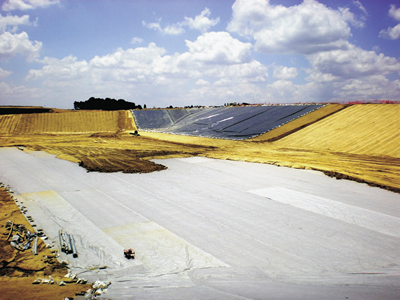 |
South Africa has recently seen the publication of numerous new pieces of legislation and new regulations pertaining to the environmental engineering and management fields. These new regulations are generally more stringent than the legislation they replace, and if not considered, will result in an increased risk of falling foul of the law. Due to the nature and scope of the changes, at Jones & Wagener we have recognized the importance of having dedicated specialist teams in the Environmental Sciences and Environmental Engineering fields that are tasked with keeping abreast of the changes and then passing this information on to our clients as well as incorporating them in our designs.
An example of particular interest to the GIGSA membership is the new landfill liner design standards. The liner designs included in the Department of Water Affairs & Forestry’s Minimum Requirements for Waste Disposal by Landfill (Second Edition, 1998) will be replaced by those in the Draft National Standard for Disposal of Waste to Landfill issued for comment under the National Environmental Management: Waste Act (59/2008) (General notice 432, Government Gazette No 34414 of 1 July 2011), once finalized and promulgated. Key to the new philosophy is that the design must consider all the elements of the containment barrier system, as opposed to designing for individual elements in a recipe fashion. For municipal landfill sites there has been a significant increase in containment standards with the inclusion of a composite liner consisting of geomembrane and clay or geocomposites clay liner (GCL). This change is especially notable for sites that had previously been classified as being in water deficit areas. Hazardous waste landfills now require an additional secondary composite liner and a geotextile filtration layer above the primary leachate collection layer.
 |
The inclusion of composite liners undoubtedly increases the environmental containment standards of these facilities. They do however introduce more potential interface failure planes, especially when applied to slopes, and increase the complexity of construction. Recent test work we have undertaken has demonstrated to us the importance of site specific friction interface testing on the actual geosynthetics to be used with the actual site soil. Basing a design on assumptions of interface friction angles, even if these were the results of previous test work on other sites, will increase the risk of a lining system stability failure significantly unless extremely conservative data is used. The other implication is that designers need to communicate with clients the time and cost implications for undertaking this test work. There is currently a lack of suitable 300 x 300 mm interface shear box test equipment in South Africa, resulting in the tests being expensive as they have to be conducted overseas.
The standards for capping of waste facilities are also being revised at present with an initial authority and industry workshop held in 2011. The new standards will undoubtedly contain geosynthetic elements. Again the containment barrier philosophy will have to be applied with particular emphasis on interface friction design and the drainage of pressures below and on top of the geosynthetic elements in the cap to mitigate the risk of veneer failures.
We are excited about the prospect of applying the new standards. Although they introduce more complexity in the design stage, as well as technical challenges in the construction phase, they also represent an opportunity to raise the standard of work done in the geosynthetics field in South Africa to that of international best practice. The new standards will also significantly reduce both the environmental risks of our clients and the risk of contaminating our precious natural resources.
Jonathan Shamrock works for Jones & Wagener, +27 (0) 11 519 0200, shamrock@jaws.co.za, www.jaws.co.za.
NOTE: This article first appeared in the February 2012 GIGSA Newsletter from the Geosynthetics Interest Group of South Africa (www.gigsa.org) and appears here by permission of the Newsletter’s editor, Peter Davies. We thank him and his chapter colleagues for sharing their expertise with the international engineering community. GIGSA is a chapter of the International Geosynthetics Society (IGS).











